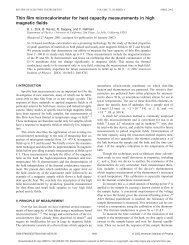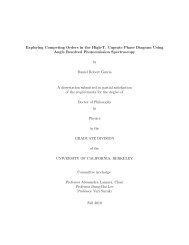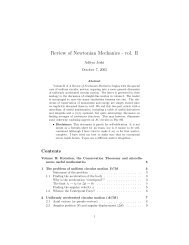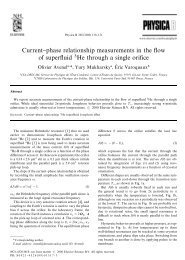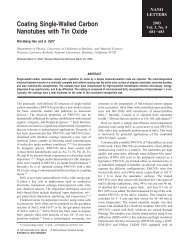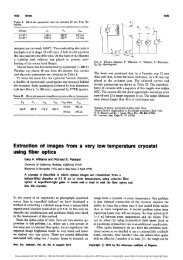Dirac Fermions in Graphene and Graphiteâa view from angle ...
Dirac Fermions in Graphene and Graphiteâa view from angle ...
Dirac Fermions in Graphene and Graphiteâa view from angle ...
Create successful ePaper yourself
Turn your PDF publications into a flip-book with our unique Google optimized e-Paper software.
Chapter 3<br />
Growth <strong>and</strong> characterization of<br />
epitaxial graphene<br />
This chapter describes the growth <strong>and</strong> characterization of epitaxial graphene us<strong>in</strong>g various experimental<br />
techniques. The samples are grown by thermal decomposition of SiC. The surface topography is studied with<br />
scann<strong>in</strong>g electron microscopy (SEM) <strong>and</strong> low energy electron microscopy (LEEM). The sample thickness is<br />
determ<strong>in</strong>ed by XPS, ARPES <strong>and</strong> LEEM.<br />
3.1 Growth of epitaxial graphene<br />
<strong>Graphene</strong> films were produced on the Si-term<strong>in</strong>ated (0001) face of an n-type 6H-SiC s<strong>in</strong>gle crystall<strong>in</strong>e<br />
wafer purchased <strong>from</strong> Cree, Inc. The wafer was cut to pieces of a few mm <strong>in</strong> size by us<strong>in</strong>g a diamond saw,<br />
<strong>and</strong> cleaned with acetone <strong>and</strong> isopropyl alcohol <strong>in</strong> an ultrasonic bath. The clean wafers were then mounted<br />
with Ta-foil clips to a Mo sample holder <strong>and</strong> entered <strong>in</strong>to an ultrahigh-vacuum preparation chamber (base<br />
pressure 1×10 −10 Torr). Before grow<strong>in</strong>g graphene layers, the wafer was cleaned <strong>in</strong> situ by anneal<strong>in</strong>g up to 850<br />
◦ C under silicon flux for 20 to 30 m<strong>in</strong>utes. The silicon flux was produced by a silicon <strong>in</strong>got heated by electron<br />
bombardment to approximately 1200 ◦ C <strong>and</strong> was calibrated with a quartz crystal monitor (deposition rate<br />
about 3 Å/m<strong>in</strong>). This procedure removes native surface oxides by the formation of volatile SiO, which<br />
sublime at this temperature 36 .<br />
The growth process was monitored by LEED patterns, which were obta<strong>in</strong>ed at room temperature. The<br />
data reported below are ma<strong>in</strong>ly <strong>from</strong> three samples, henceforth referred to as samples A, B, <strong>and</strong> C. These<br />
samples are labeled <strong>in</strong> order of <strong>in</strong>creas<strong>in</strong>g thickness, a parameter controlled primarily by variation <strong>in</strong> the<br />
anneal<strong>in</strong>g temperature 37 .<br />
Fig. 3.1 shows selected LEED patterns obta<strong>in</strong>ed at different stages dur<strong>in</strong>g the growth of sample A. After<br />
the <strong>in</strong>itial clean<strong>in</strong>g procedure under Si flux, the LEED pattern (not shown) displayed a 3×3 reconstruction<br />
with respect to the SiC substrate, as has been well documented <strong>in</strong> the literature 36,38,39 . A subsequent 5<br />
m<strong>in</strong>ute anneal<strong>in</strong>g at ≈ 1000 ◦ C <strong>in</strong> the absence of Si flux gives rise to the sharp pattern shown <strong>in</strong> panel (a),<br />
correspond<strong>in</strong>g to the 1×1 spots of SiC. Further anneal<strong>in</strong>g for 5 m<strong>in</strong> at ≈ 1100 ◦ C produces the ( √ 3× √ 3)R30<br />
reconstruction shown <strong>in</strong> panel (b), attributed to a structural model comprised of 1/3 layer of Si adatoms <strong>in</strong><br />
threefold symmetric sites on top of the outermost SiC bilayer 40,41 . F<strong>in</strong>ally, anneal<strong>in</strong>g for 10 m<strong>in</strong> at ≈ 1250 ◦ C<br />
17





